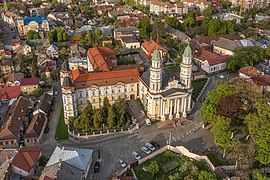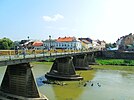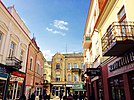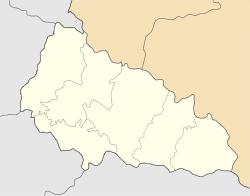Uzhhorod
Uzhhorod
Ужгород | |
|---|---|
City | |
| |
| Coordinates: 48°37′26″N 22°17′42″E / 48.62389°N 22.29500°E | |
| Country | |
| Oblast | Zakarpattia Oblast |
| Raion | Uzhhorod Raion |
| Hromada | Uzhhorod urban hromada |
| Founded | 9th century |
| Government | |
| • Mayor | Bohdan Andriiv[1] (self-nominated[1]) |
| Area | |
• Total | 65 km2 (25 sq mi) |
| Elevation | 169 m (554 ft) |
| Population (2022) | |
• Total | 115,449 |
| • Density | 3,662/km2 (9,480/sq mi) |
| Time zone | UTC+2 (EET) |
| • Summer (DST) | UTC+3 (EEST) |
| Postal code | 88000 |
| Area codes | +380-312 |
| Sister cities | Békéscsaba, Nyíregyháza, Krosno, Trogir, Pula, Corvallis, Darmstadt, Košice |
| Climate | Cfb |
| Website | rada-uzhgorod |
 | |
Uzhhorod (Ukrainian: Ужгород, IPA: [ˈuʒɦorod]; Hungarian: Ungvár, IPA: [ˈuŋɡvaːr]; Slovak: Užhorod) is a city and municipality on the Uzh River in western Ukraine, at the border with Slovakia and near the border with Hungary. The city is approximately equidistant from the Baltic, the Adriatic and the Black Sea (650–690 km) making it the most inland city in this part of Europe. It is the administrative center of Zakarpattia Oblast (region), as well as the administrative center of Uzhhorod Raion (district) within the oblast. Population: 115,449 (2022 estimate).[2]
Name
[edit]The city's earliest known name is Ungvár, from Hungarian Ung (River Uzh) and vár "castle, fortress", originally referring to a castle outside the city (probably Nevytske Castle[3]).[4][5]
The name Uzhhorod was coined in early 19th century Slavophile circles as a literal translation of the name Ungvár.[4][5] The city officially adopted this name some time after 1920, under Czechoslovak administration.
The names of the city also include: English: Uzhgorod (before 1996); Rusyn: Ужгород, romanized: Užhorod, Rusyn: Унґвар, romanized: Ungvar (historically); Russian: Ужгород, romanized: Užgorod; Belarusian: Ужгарад, romanized: Užharad; Yiddish: אונגווער, romanized: Ungver, Yiddish: אונגוואַר, romanized: Ungvar; Czech: Užhorod; Slovak: Užhorod; German: Ungwar, Ungarisch Burg or Ungstadt; Polish: Użhorod; Romanian: Ujgorod.
History
[edit]This section may require cleanup to meet Wikipedia's quality standards. The specific problem is: Spelling, capitalization, and grammar issues. (September 2023) |
This section needs additional citations for verification. (September 2023) |
Early history
[edit]White-Croat Ungvar (677)
[edit]
The city was founded by early Slavs, one tribe of whom was the White Croats, who settled the area of the modern Uzhhorod under Kuber in the second half of the first millennium AD.[6]Warriors from Ukraine established the Ungvar fortress in 677 according to the Chronicon Pictum. The settlement was the center of a new Slavic principality headed by a dynasty descended from Porga's nephew Kubrat. In the 9th century, the fortified castle changed into a fortified early feudal town-settlement which according to Gesta Hungarorum was originally subject to the Old Bulgarian Prince Salan until falling to Laborec, a ruler who was loyal to Great Moravia.[6]
Magyar conquest (895)
[edit]Almos's Magyars who had arrived in the region from Kyiv stormed the Hunguar fortress in 895 AD. Having taken over the castle, Almos appointed his son Árpád as prince of Hunguaria and from Ungvar his warriors were called Hungarians.[7] As this may be viewed as naive folk etymology by a medieval writer, for further information on the ethnonym of the Hungarians see the article Name of Hungary.[citation needed]
In the Kingdom of Hungary, the small town began to extend its borders. King Saint Stephen made it the centre (castrum) of Ung county with a strong military presence to protect the north east border of Hungary. In 1241–1242 the Mongols of Batu Khan burnt the settlement. After, in 1248 the city was granted town privileges by the King Béla IV of Hungary. In the early 14th century, Uzhhorod was involved in the civil wars in the interregnum between Hungarian barons when the dynasty of Árpád died out. Finally Charles I of Hungary from the Anjou dynasty, descendant of the House of Árpád by his mother occupied the throne. The Anjou House also ruled the Kingdom of Naples and the Hungarian king Charles I invited the Drugeths (Italian counts from the Kingdom of Naples) into Hungary and gave the town to them. The Drugeth family became a member of the Hungarian nobility. During that period Philip Drugeth built Uzhhorod Castle. Together with the castle, the city began to grow. From 1430, Uzhhorod became a free royal town.
Under Habsburg rule
[edit]During the 16–17th centuries The Kingdom of Hungary fell into three parts. The middle was occupied by the Ottoman Empire, the north west was ruled by the Habsburg dynasty, the eastern part became the Principality of Transylvania, that hold the independent Hungarian statehood. During this period there were many handicraft corporations in Uzhhorod. In this period the city was engaged in the religious and political fight between primarily Hungarian Protestant Transylvania and the German Catholic Austria. Each one wanted to reunite the Kingdom of Hungary under their rule. In 1646 the Union of Ungvár was proclaimed and the Greek-Catholic church was established, in a ceremony held in the Ungvár castle by the Vatican Aegis. In 1707 Ungvár was the residence of Ferenc II Rákóczi, leader of the national liberation war of Hungarians against Habsburgs. From 1780 the city became the capital of the Greek Catholic Eparchy and from 1776 the center of a newly created school district.[6]
The beginning of the 19th century was characterized by economic changes, including the first factories in the city. The greatest influence on Ungvár among the political events of the 19th century was made by the Hungarian Revolution of 1848-1849, during which the native Hungarian nobility sought both to shake off the suzerainty of the Austrian Empire and to have authority over their own people. 27 March 1848 was officially celebrated in the city as the overthrow of the monarchy in Hungary. It is now celebrated in Hungary on 15 March.
In 1872 the first railway line opened, linking the city to the important railway junction of Chop, then known as Csap.
According to the 1910 census, the city had 16,919 inhabitants, of which 13,590 (80.3%) were Magyars, 1,219 (7.2%) Slovaks, 1,151 (6.8%) Germans, 641 (3.8%) Rusyns and 1.6% Czechs.[8] By religion, 5,481 Roman Catholic, 5,305 Jewish, 4,473 Greek Catholic, 1,368 Calvinist. At the same time, the municipal area of the city had a population composed of 10,541 (39.05%) Hungarians, 9,908 (36.71%) Slovaks, and 5,520 (20.45%) Rusyns.[9]
During the World Wars
[edit]The First World War slowed down the tempo of city development. On 10 September 1919, Subcarpathia was officially allocated to the Republic of Czechoslovakia. Uzhhorod became the administrative center of the territory. During these years Uzhhorod developed into an architecturally modern city, with Malyi Galagov, a new government quarter, being built from scratch.[10]
After the First Vienna Award in 1938, Uzhhorod was given back to Hungary from which it was separated after World War I.
In 1941 the Jewish population reached 9,576.[citation needed] On 19 March 1944, German troops entered the city. They established a Judenrat (Jewish council) and set up two ghettos, at the Moskovitz brickyard and Gluck lumberyard. During May 1944, all Jews were deported to Auschwitz in five different transports and subsequently murdered. Only a few hundred Jews survived.[11]
In the Soviet Union
[edit]On 27 October 1944, the city was captured by the troops of the 4th Ukrainian Front of the Red Army.[citation needed]
This period brought significant changes. On the outskirts of Uzhhorod new enterprises were constructed and the old enterprises were renewed.[citation needed] On 29 June 1945, Subcarpathian Ukraine was annexed by the Soviet Union and became a westernmost part of the Ukrainian SSR. This followed the assumption of local authority by the People's Committee of Transcarpathian Ukraine based in Uzhhorod and headed by a local Communist.[12] That year the Uzhhorod State University (now Uzhhorod National University) was also opened. Since January 1946 Uzhhorod was the center of newly formed Zakarpatska oblast.[1]
In Ukraine
[edit]Since 1991 Uzhhorod has become one of 24 regional capitals within independent Ukraine. Of these, Uzhhorod is the smallest and westernmost.

In 2002, a bust of Tomáš Masaryk, Czechoslovakia's first president, was unveiled in a main square of the city. A similar bust was unveiled in 1928 on the 10th anniversary of Czechoslovak independence, but was removed by the Hungarians when they took over the region in 1939.[13]
On 15 April 2022, as part of the derussification campaign that swept through Ukraine following the February 2022 Russian invasion of Ukraine, the Uzhhorod City Council decided to rename 58 streets connected to Russian figures.[14] United States First Lady Jill Biden visited the city on 8 May 2022, which was not announced to the public until after the visit.[15]
Geography
[edit]Climate
[edit]
Uzhhorod has a humid continental climate (Köppen: Dfb) with cool to cold winters and warm summers. The coldest month is January with an average temperature of −1.7 °C (28.9 °F) while the warmest month is July with an average temperature of 20.9 °C (69.6 °F).[16] The coldest temperature ever recorded is −28.2 °C (−18.8 °F) and the warmest temperature was 38.6 °C (101.5 °F). Average annual precipitation is 748 millimetres (29.4 in), which is evenly distributed throughout the year though the summer months have higher precipitation.[16] On average, Uzhhorod receives 2023 hours of sunshine per year.[17]
| Climate data for Uzhhorod (1991–2020, extremes 1947–present) | |||||||||||||
|---|---|---|---|---|---|---|---|---|---|---|---|---|---|
| Month | Jan | Feb | Mar | Apr | May | Jun | Jul | Aug | Sep | Oct | Nov | Dec | Year |
| Record high °C (°F) | 13.3 (55.9) |
19.2 (66.6) |
25.4 (77.7) |
29.7 (85.5) |
33.4 (92.1) |
35.0 (95.0) |
38.6 (101.5) |
38.4 (101.1) |
35.9 (96.6) |
26.1 (79.0) |
23.3 (73.9) |
15.6 (60.1) |
38.6 (101.5) |
| Mean daily maximum °C (°F) | 1.7 (35.1) |
4.3 (39.7) |
10.4 (50.7) |
17.4 (63.3) |
22.1 (71.8) |
25.5 (77.9) |
27.6 (81.7) |
27.7 (81.9) |
21.9 (71.4) |
15.6 (60.1) |
9.2 (48.6) |
3.0 (37.4) |
15.5 (59.9) |
| Daily mean °C (°F) | −1.2 (29.8) |
0.6 (33.1) |
5.4 (41.7) |
11.5 (52.7) |
16.1 (61.0) |
19.6 (67.3) |
21.3 (70.3) |
21.1 (70.0) |
15.9 (60.6) |
10.5 (50.9) |
5.4 (41.7) |
0.3 (32.5) |
10.5 (50.9) |
| Mean daily minimum °C (°F) | −4.2 (24.4) |
−3.0 (26.6) |
0.8 (33.4) |
5.6 (42.1) |
10.1 (50.2) |
13.7 (56.7) |
15.3 (59.5) |
14.9 (58.8) |
10.4 (50.7) |
5.9 (42.6) |
1.9 (35.4) |
−2.3 (27.9) |
5.8 (42.4) |
| Record low °C (°F) | −28.2 (−18.8) |
−26.3 (−15.3) |
−17.5 (0.5) |
−6.9 (19.6) |
−4.4 (24.1) |
1.5 (34.7) |
5.4 (41.7) |
4.4 (39.9) |
−2.2 (28.0) |
−9.3 (15.3) |
−21.8 (−7.2) |
−24.7 (−12.5) |
−28.2 (−18.8) |
| Average precipitation mm (inches) | 54 (2.1) |
53 (2.1) |
41 (1.6) |
45 (1.8) |
69 (2.7) |
68 (2.7) |
82 (3.2) |
67 (2.6) |
68 (2.7) |
62 (2.4) |
58 (2.3) |
64 (2.5) |
731 (28.8) |
| Average extreme snow depth cm (inches) | 7 (2.8) |
7 (2.8) |
1 (0.4) |
0 (0) |
0 (0) |
0 (0) |
0 (0) |
0 (0) |
0 (0) |
0 (0) |
0 (0) |
4 (1.6) |
7 (2.8) |
| Average rainy days | 11 | 10 | 13 | 15 | 16 | 16 | 15 | 13 | 13 | 13 | 14 | 13 | 162 |
| Average snowy days | 14 | 12 | 5 | 1 | 0.03 | 0 | 0 | 0 | 0 | 0.3 | 5 | 12 | 49 |
| Average relative humidity (%) | 82.6 | 76.2 | 67.4 | 61.4 | 65.2 | 68.0 | 67.4 | 68.6 | 72.8 | 76.0 | 80.1 | 83.3 | 72.4 |
| Mean monthly sunshine hours | 55.8 | 87.0 | 152.7 | 202.4 | 266.2 | 266.3 | 279.1 | 269.2 | 189.8 | 140.4 | 71.4 | 45.8 | 2,023.1 |
| Source 1: Pogoda.ru.net[16] | |||||||||||||
| Source 2: World Meteorological Organization (humidity and sun 1981–2010)[17] | |||||||||||||
Demographics
[edit]| Year | Pop. | ±% |
|---|---|---|
| 1921 | 20,601 | — |
| 1930 | 26,675 | +29.5% |
| 1939 | 30,000 | +12.5% |
| 1959 | 47,396 | +58.0% |
| 1970 | 64,578 | +36.3% |
| 1979 | 90,995 | +40.9% |
| 1989 | 117,061 | +28.6% |
| 2001 | 117,317 | +0.2% |
| 2011 | 116,423 | −0.8% |
| 2022 | 115,449 | −0.8% |
| Source: [18][19] | ||
According to the Ukrainian 2001 census, the population of Uzhhorod included:[20]
- Ukrainians (including Rusyns)[citation needed] (77.8%)
- Russians (9.6%)
- Hungarians (6.9%)
- Slovaks (2.2%)
- Romani (1.5%)
Language
[edit]Distribution of the population by native language according to the 2001 census:[21]
| Language | Number | Percentage |
|---|---|---|
| Ukrainian | 89 624 | 77.55% |
| Russian | 14 335 | 12.40% |
| Hungarian | 8 123 | 7.03% |
| Romani | 1 494 | 1.29% |
| Other or undecided | 1 992 | 1.73% |
| Total | 115 568 | 100.00 % |
According to a survey conducted by the International Republican Institute in April–May 2023, 85% of the city's population spoke Ukrainian at home, 9% spoke Russian, and 1% spoke Hungarian.[22]
Transportation
[edit]
The city is served by Uzhhorod railway station and has railway connections with Chop and Lviv. It is also served by Uzhhorod International Airport.[23] The airport is situated near the Ukraine Slovakia border.[24]
Government
[edit]The territory of the city of Uzhhorod is coterminous with Uzhhorod urban hromada, one of the hromadas of Ukraine which was established on 12 June 2020.[25][26]
Sport
[edit]The city was home to the SC Rusj Užhorod football club from 1925. Contemporary side FC Hoverla Uzhhorod made their debut in the Ukrainian Premier League in 2001, but dissolved in 2016 due to money issues.[27]
In 2020 professional football matches at the highest levels of Ukraine returned to Uzhhorod since the 2020–21 season FC Mynai plays its home matches in the Avanhard Stadium.[28] FC Uzhhorod currently in Ukrainian Second League also plays its matches at Avanhard Stadium.
International relations
[edit]Uzhhorod is currently twinned with:
 Békéscsaba, Hungary
Békéscsaba, Hungary Nyíregyháza, Hungary
Nyíregyháza, Hungary Szombathely, Hungary
Szombathely, Hungary Trogir, Croatia
Trogir, Croatia Pula, Croatia
Pula, Croatia Corvallis, Oregon, US
Corvallis, Oregon, US Darmstadt, Germany, since 1992[29]
Darmstadt, Germany, since 1992[29] Košice, Slovakia, since 1993[30]
Košice, Slovakia, since 1993[30] Krosno, Poland, since 2008[31]
Krosno, Poland, since 2008[31] Jarosław, Poland, since 2002[32]
Jarosław, Poland, since 2002[32] Česká Lípa, Czech Republic
Česká Lípa, Czech Republic Satu Mare, Romania[33]
Satu Mare, Romania[33] Târgu Mureș, Romania
Târgu Mureș, Romania
Notable people
[edit]



- Arieh Atzmoni (1926–2005) an Israeli soldier rewarded with the Hero of Israel
- János Erdélyi (1814 in Veľké Kapušany – 1868) Hungarian poet, critic, author and philosopher.[34]
- Mihály Fincicky (1842–1916), Hungarian folklorist and mayor
- Renée Firestone (born 1924), Holocaust survivor, fashion designer
- Lisa Fittko (1909–2005) author and helper to many escaping Nazi-occupied France during WWII.
- Wilem Frischmann (born 1931) WWII refugee, became a leading British engineer
- Shlomo Ganzfried (1804–1886), an Orthodox rabbi of Ungvar and posek
- József Gáti (1885–1945) an ethnic Hungarian communist politician from Subcarpathian Rus
- Jenő Janovics (1872–1945) a Hungarian film director, screenwriter and actor of the silent era.
- Józef Kasparek (1915 in Broumov - 2002), a Polish lawyer, historian and political scientist in the US; carried out covert operations in Carpathian Rus 1938/39.
- Mikhail Kopelman (born 1947), a Russian-American violinist, first violin in the Kopelman Quartet
- Joseph L. Kun (1882–1961), emigrated to the US aged 4, became a judge in Pennsylvania
- Serhiy Kvit (born 1965), a Ukrainian literary critic, journalist, educator and social activist.
- Samuel Lipschütz (1863–1905), a chess player and author
- Nil Lushchak (born 1973) a Ruthenian Catholic hierarch for Mukachevo.
- Jonathan Markovitch (born 1967) a Ukrainian rabbi and the Chief rabbi of Kyiv
- József Örmény (born 1960), a Ukrainian pianist of Hungarian origin.
- Ilka Pálmay (1859–1945), a Hungarian-born singer and actress.
- Géza Pap (1883–1912), socialist from the Austro-Hungarian Empire
- Dezső Pattantyús-Ábrahám (1875–1973) a Hungarian politician from an ancient and noble family
- Serhiy Ratushniak (born 1961) former long-term Mayor of Uzhhorod, 1994–2002 & 2006–2010
- Lika Roman (born 1985), a Ukrainian model, charity worker and Miss Ukraine, 2007
- Zsuzsanna Sirokay (born 1941) a Hungarian pianist, she lives in Switzerland.
- Avgustyn Voloshyn (1874 in Kelechyn – 1945), a Subcarpathian politician, teacher and priest
- Yolka (born 1982), singer, songwriter, recording artist, presenter and actress.
- Anatoly Zatin (born 1954), a Mexican composer, pianist and orchestral conductor
- Gregory Zatkovich (1886 in Holubyne – 1967), an American lawyer and first governor of Carpathian Ruthenia
- Paul Zatkovich (1852—1916) newspaper editor and cultural activist for Rusyns in the US.
Sport
[edit]- Matviy Bobal (born 1984) a Ukrainian football forward with ca. 300 club caps
- Juraj Demeč (born 1945) a Czechoslovak former track and field athlete who competed at the 1972 Summer Olympics
- Vladimir Koman (born 1989), a footballer with nearly 300 club caps and 36 for Hungary
- Vladyslav Mykulyak (born 1984) a Ukrainian retired footballer with 320 club caps.
- Yozhef Sabo (born 1940), a former football player with 347 club caps and 76 for the Soviet Union
- György Sándor (born 1984) a Carpathian Ruthenian footballer with 370 club caps and 9 for Hungary
- István Sándor (born 1986) a Hungarian footballer with 380 club caps
- Daria Shestakova (born 1996) a Russian rugby sevens player.
- Tetyana Trehubová (born 1989) a Ukrainian-born Slovak handball player.
- Odarka Sopko (born 1955), a Ukrainian artist and graphic painter.
See also
[edit]References
[edit]- ^ a b National parties lose out to local candidates in Ukraine’s 2020 municipal elections UkraineAlert by Brian Mefford, Atlantic Council (12 December 2020)
CEC names winners of mayoral elections in Uzhgorod, Berdiansk, Sloviansk, Interfax-Ukraine (23 November 2020) - ^ Чисельність наявного населення України на 1 січня 2022 [Number of Present Population of Ukraine, as of January 1, 2022] (PDF) (in Ukrainian and English). Kyiv: State Statistics Service of Ukraine. Archived (PDF) from the original on 4 July 2022.
- ^ Németh, Péter (2007). "Álom és valóság: Ung vára" (PDF). Castrum. 6: 5–10. ISSN 1787-1093.
- ^ a b Sebestyén, Zsolt (2020). "Ungvár, Ужгород". Kárpátalja helységnevei [The Placenames of Transcarpathia] (PDF) (in Hungarian). Nyíregyháza. pp. 457–459. ISBN 978-973-0-31294-2.
{{cite book}}: CS1 maint: location missing publisher (link) - ^ a b Галас, Кирило (2002). ""Словник українських топонімів Закарпаття" (фрагменти)". Сучасні проблеми мовознавства та літературознавства. 6: 365–376.
- ^ a b c A 1777 évi Ratio educationis. 1913.
- ^ Deeds of the Hungarians by Anonymous, Chapter 13
- ^ Atlas and Gazetteer of Historic Hungary 1914, Talma Kiadó Archived 14 January 2017 at the Wayback Machine
- ^ "Ung County". Genealogy Online. Archived from the original on 29 March 2008. Retrieved 17 March 2007.
- ^ "Uzhhorod Modernism". am.umodernism.com. Retrieved 28 June 2019.
- ^ "Uzhorod". Kehilalinks. Retrieved 22 March 2017.
- ^ "People's Council of Transcarpathian Ukraine". Internet Encyclopedia of Ukraine. 2001. Retrieved 12 June 2023.
- ^ PRECLÍK, Vratislav: "Profesor Masaryk a Podkarpatská Rus právě před sto lety" (Professor Masaryk and Subcarpatian Russia just hundred years ago), in Čas: časopis Masarykova demokratického hnutí, leden - březen 2019, roč.XXVII. čís. 125. ISSN 1210-1648, str.18 – 23
- ^ ROMAN PETRENKO (15 April 2022). "Ужгород тотально дерусифікують" [Uzhhorod is totally derusified]. Ukrainska Pravda (in Ukrainian). Retrieved 1 November 2022.
- ^ "First lady Jill Biden makes unannounced trip to Ukraine". CNN. 8 May 2022.
- ^ a b c "Pogoda.ru.net". Weather and Climate for Uzhhorod (in Russian). Archived from the original on 14 December 2019. Retrieved 8 November 2021.
- ^ a b "World Meteorological Organization Climate Normals for 1981–2010". World Meteorological Organization. Archived from the original on 17 July 2021. Retrieved 17 July 2021.
- ^ "Population development in Subcarpathian Rus since 1918" (PDF) (in Czech).
- ^ "Cities & Towns of Ukraine".
- ^ "Zakarpattia Region". Ukrainian 2001 census. Archived from the original on 11 September 2007. Retrieved 17 March 2007.
- ^ "Рідні мови в об'єднаних територіальних громадах України" (in Ukrainian).
- ^ "Восьме всеукраїнське муніципальне опитування" (PDF). ratinggroup.ua (in Ukrainian).
- ^ Flights to resume at Uzhgorod Airport as Ukraine, Slovakia reportedly settle border issues, UNIAN (19 August 2020)
- ^ "Uzhhorod is now the most sensitive Airport in Ukraine as it literally touches Slovakia, a NATO country". 24 March 2022.
- ^ "Ужгородська територіальна громада. Загальна інформація". decentralization.gov.ua/. Retrieved 10 January 2021.
- ^ "Про визначення адміністративних центрів та затвердження територій територіальних громад Закарпатської області" (in Ukrainian). Retrieved 6 October 2023.
- ^ "Велика пихатість маленького клубу. Як команда-привид збирала зірок" [The great pomp of the little club. How the ghost team collected stars]. UA-Football. 2 April 2018. Retrieved 7 April 2018.
- ^ "Minai will play home matches of the Premier League at Avangard Stadium in Uzhhorod". PMG.ua (in Ukrainian). 19 August 2020. Retrieved 19 August 2020.
- ^ "Städtepartnerschaften und Internationales". Büro für Städtepartnerschaften und internationale Beziehungen (in German). Archived from the original on 23 July 2013. Retrieved 26 July 2013.
- ^ "Twin cities of the City of Kosice". Magistrát mesta Košice, Tr. Archived from the original on 5 November 2013. Retrieved 27 July 2013.
- ^ "Krosno Official Website – Partner Cities" (in Polish). Urząd Miasta Krosna. Retrieved 23 October 2008.
- ^ "Jarosław Official Website – Partner Cities" (in Polish). Urząd Miasta Jarosław. Ul. Rynek 1, 37–500 Jarosław. Retrieved 23 October 2008.
- ^ "Protocol de colaborare Ujgorod-Satu Mare" (in Romanian). www.satu-mare.ro. Archived from the original on 27 May 2013. Retrieved 27 June 2009.
- ^ . Encyclopædia Britannica. Vol. 9 (11th ed.). 1911. p. 734.
Further reading
[edit]- Rampley, Matthew (2019). "Uzhhorod Modernism" (2019). https://craace.com/2019/05/09/uzhhorod-modernism/
- Véghseő, Tamás (2015). "Reflections on the Background to the Union of Uzhhorod / Ungvár (1646)" (PDF). Eastern Theological Journal. 1 (1): 147–181.










